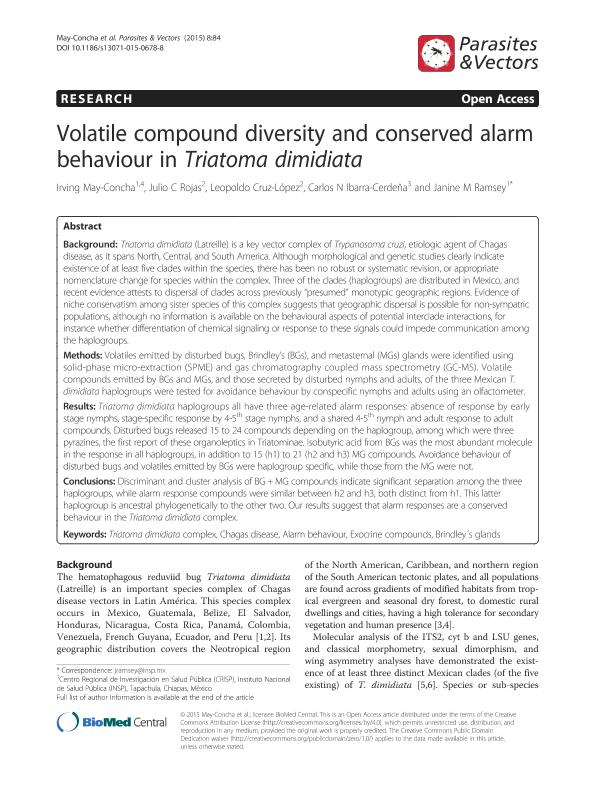Artículo
Volatile compound diversity and conserved alarm behaviour in Triatoma dimidiata
May Concha, Irving Jesus ; Rojas, Julio C.; Cruz López, Leopoldo; Ibarra-Cerdeña, Carlos N.; Ramsey, Janine
; Rojas, Julio C.; Cruz López, Leopoldo; Ibarra-Cerdeña, Carlos N.; Ramsey, Janine
 ; Rojas, Julio C.; Cruz López, Leopoldo; Ibarra-Cerdeña, Carlos N.; Ramsey, Janine
; Rojas, Julio C.; Cruz López, Leopoldo; Ibarra-Cerdeña, Carlos N.; Ramsey, Janine
Fecha de publicación:
02/2015
Editorial:
BioMed Central
Revista:
Parasites and Vectors
ISSN:
1756-3305
Idioma:
Inglés
Tipo de recurso:
Artículo publicado
Clasificación temática:
Resumen
Background: Triatoma dimidiata (Latreille) is a key vector complex of Trypanosoma cruzi, etiologic agent of Chagas disease, as it spans North, Central, and South America. Although morphological and genetic studies clearly indicate existence of at least five clades within the species, there has been no robust or systematic revision, or appropriate nomenclature change for species within the complex. Three of the clades (haplogroups) are distributed in Mexico, and recent evidence attests to dispersal of clades across previously "presumed"monotypic geographic regions. Evidence of niche conservatism among sister species of this complex suggests that geographic dispersal is possible for non-sympatric populations, although no information is available on the behavioural aspects of potential interclade interactions, for instance whether differentiation of chemical signaling or response to these signals could impede communication among the haplogroups. Methods: Volatiles emitted by disturbed bugs, Brindley's (BGs), and metasternal (MGs) glands were identified using solid-phase micro-extraction (SPME) and gas chromatography coupled mass spectrometry (GC-MS). Volatile compounds emitted by BGs and MGs, and those secreted by disturbed nymphs and adults, of the three Mexican T. dimidiata haplogroups were tested for avoidance behaviour by conspecific nymphs and adults using an olfactometer. Results: Triatoma dimidiata haplogroups all have three age-related alarm responses: absence of response by early stage nymphs, stage-specific response by 4-5th stage nymphs, and a shared 4-5th nymph and adult response to adult compounds. Disturbed bugs released 15 to 24 compounds depending on the haplogroup, among which were three pyrazines, the first report of these organoleptics in Triatominae. Isobutyric acid from BGs was the most abundant molecule in the response in all haplogroups, in addition to 15 (h1) to 21 (h2 and h3) MG compounds. Avoidance behaviour of disturbed bugs and volatiles emitted by BGs were haplogroup specific, while those from the MG were not. Conclusions: Discriminant and cluster analysis of BG +MG compounds indicate significant separation among the three haplogroups, while alarm response compounds were similar between h2 and h3, both distinct from h1. This latter haplogroup is ancestral phylogenetically to the other two. Our results suggest that alarm responses are a conserved behaviour in the Triatoma dimidiata complex.
Archivos asociados
Licencia
Identificadores
Colecciones
Articulos(CICYTTP)
Articulos de CENTRO DE INV.CIENT.Y TRANSFERENCIA TEC A LA PROD
Articulos de CENTRO DE INV.CIENT.Y TRANSFERENCIA TEC A LA PROD
Citación
May Concha, Irving Jesus; Rojas, Julio C.; Cruz López, Leopoldo; Ibarra-Cerdeña, Carlos N.; Ramsey, Janine; Volatile compound diversity and conserved alarm behaviour in Triatoma dimidiata; BioMed Central; Parasites and Vectors; 8; 1; 2-2015; 1-14
Compartir
Altmétricas



